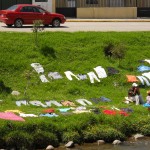While living in Cuenca, Ecuador, we heard about the only Inca ruins in Ecuador. I love visiting ruins, and these are a bit unique, so I couldn’t resist. A local Spanish teacher was taking a group of people on a day trip that sounded wonderful, and we decided to join her and a handful of tourists.
We began the day with a trip to some Cañari ruins on a small mountain known as Cojitambo. The Cañari were a pre-Incan civilization that inhabited a large part of this section of Ecuador. This area provided a great view of the surrounding valleys, including the nearby sacred Pachamama, and thus served as a lookout point for soldiers. After a picnic breakfast, it was time to move on to Cañar.
The beautiful Ecuadorian countryside alone is worth the few-hour drive. Away from the cities you are treated to sights of local indigenous life. Here there is no need for the high, broken glass-lined or electrified walls that protect homes in the more populated towns.
The ruins of Ingapirca (translation: Inca wall or Place of the Incas, depending who you ask) do not receive a lot of attention. The fee for admission is $6 USD (Ecuador uses the US dollar as its currency) for adults, 50% off for kids and tercera edad or senior citizens, and for the disabled. Admission includes a bilingual guide, and the tour takes around 1-1/2 hours before you are left on your own to continue to explore the site if you wish.
The site is unusual because it was once a holy place for the Cañari but became the administrative section under Incan rule. The Cañari worshiped the moon, whereas the Incas were dedicated to the sun. When the Incas arrived, they converted the site for their own use, which also involved erecting their own temples and other buildings. One of the fascinating sights at Ingapirca is that you can see the shift in construction techniques practically side by side. The Cañari used stones they gathered which were then cemented into place with a mortar combining soil, vegetation, and feces; however, the Incas are famous for their perfectly matched cut stones which fit together so precisely that you cannot insert a knife edge or a piece of paper between the stones. And they used no mortar. The difference is amazingly clear.
The ruins also demonstrate that the Cañari influenced Incan worship. The sun temple at Ingapirca is the only one discovered so far that was built in an elliptical shape, a form that more closely resembled the moon’s path in the night sky.
After the tour ends and you’ve finished checking out the main site, there are some areas that are worth exploring. If you take the small path that leads to the very small Cañari village and go up the stairs, you will be able to see the bath that was used before special ceremonies. Water was drawn from the nearby river below the hill and brought up to the special bath used for the priest and other participants.
At the end of the dirt path, you will find stone steps leading down a small, steep incline. When you reach the bottom, turn to your left and look for the special feature in the rock. You can see why this was a special spot for the area’s former inhabitants. (But I’m not going to ruin the surprise by showing a picture.)
There are several little restaurants near the ruins providing comida tipica, Ecuadorian food. I wanted to stop at the incredibly. . . rustic one located near the end of the path, but our group was going elsewhere.
Ingapirca is located a few hours from Cuenca, and there are lots of tour companies that provide trips there for fairly reasonable prices. If you plan on being in Cuenca for a while, you may want to sign up for the Gringo Tree newsletter. I’m not a big fan of the name, but the newsletter lets you know about many of the cultural activities happening in Cuenca and is really a good resource for people spending two or more weeks in Ecuador’s third largest city.
Have you visited these or other Inca ruins?












October 14, 2013
I am originally from Cuenca, Ecuador– I’ve never visited Ingapirca, but in Cuenca itself, there are plenty of Inca ruins to check-out. This is a newer phenomenon, as local archeologists are seriously excavating the whole area.
October 18, 2013
Ingapirca is wonderful since it combines two civilizations.
June 20, 2012
very nice write up! Makes me wanna pack up and go see for myself.
June 20, 2012
Thank you! It’s a cool place.